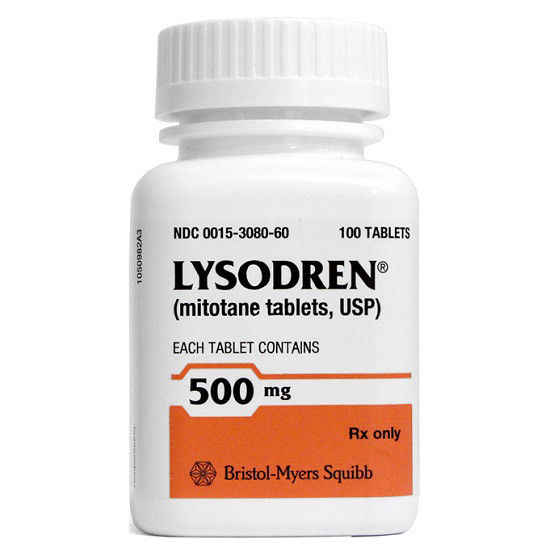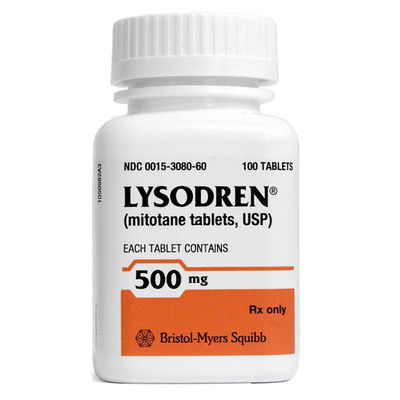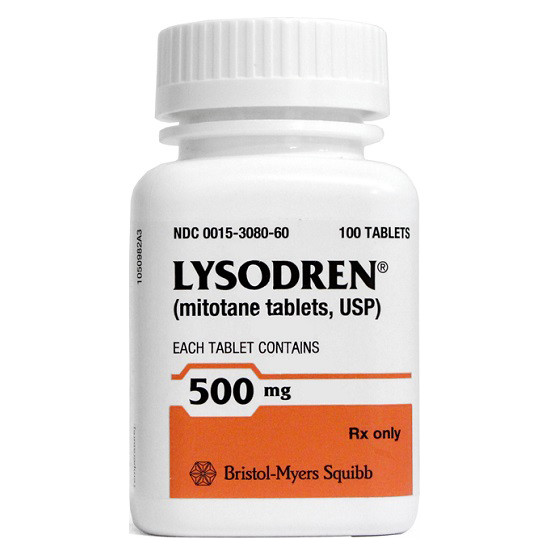500mg Mitotane Lysodren 100 Tablets For Adenoma Resolving
Indications, usage and dosage
Adjuvant treatment for adrenal cancer
Initial dose, 1.5 g/d, increase to 6 g/d within 4-6 days; after 3 weeks, adjust dose according to patient's tolerance and blood drug levels; maximum dose is 12 g/d; most people cannot tolerate it Affected by doses exceeding 8 g/d; dosing for at least 2 years, it is worth noting that many patients cannot tolerate the impact of the drug on their quality of life (guideline recommended dose).
Target plasma level, 14-20 mg/L (no grade 2 central nervous system, grade 3-4 gastrointestinal side effects); if plasma mitotane level is less than 14 mg/L, increments of 1 g/d Adjust the dose; if the blood drug level is 14-20 mg/L, maintain the current dose; if the blood drug level is greater than 20 mg/L, reduce the daily dose to 50%-75% of the current dose (guideline recommended dose).
Combination medication requires large doses of glucocorticoids; hydrocortisone 50 mg/d (divided into three doses of 20 mg, 20 mg, and 10 mg) or cortisone acetate ≥ 75 mg may be required. Glucocorticoid replacement therapy is best monitored with careful clinical evaluation. Fludrocortisone (guideline-recommended dose) may be added based on blood pressure, serum potassium levels, and plasma renin activity.
inoperable adrenal cancer
The initial dose is 2-6 g orally per day (taken in 3-4 times per day); gradually increase the dose until reaching a blood concentration of 14-20 mg/L or the patient's maximum tolerated dose (FDA recommended dose).
Initial dose, 1.5 g/d, increase to 6 g/d within 4-6 days; after 3 weeks, adjust dose according to patient's tolerance and blood drug levels; maximum dose is 12 g/d; most people cannot tolerate it Subject to doses exceeding 8 g/d (guideline recommended dose).
Target plasma level, 14-20 mg/L (no grade 2 central nervous system, grade 3-4 gastrointestinal side effects); if plasma mitotane level is less than 14 mg/L, increments of 1 g/d Adjust the dose; if the blood drug level is 14-20 mg/L, maintain the current dose; if the blood drug level is greater than 20 mg/L, reduce the daily dose to 50%-75% of the current dose (guideline recommended dose).
Combination medication requires large doses of glucocorticoids; hydrocortisone 50 mg/d (divided into three doses of 20 mg, 20 mg, and 10 mg) or cortisone acetate ≥ 75 mg may be required. Glucocorticoid replacement therapy is best monitored with careful clinical evaluation. Fludrocortisone (guideline-recommended dose) may be added based on blood pressure, serum potassium levels, and plasma renin activity.
Safe medication
Pregnancy grade C
Animal reproduction studies have proven that the drug has toxic side effects on the fetus, but adequate and rigorous controlled studies have not been conducted on pregnant women, and the therapeutic benefits of using the drug in pregnant women may outweigh the potential harm; or, the drug has not been tested on animals, nor has it been tested on animals. There are no adequately rigorously controlled studies in pregnant women.
Medication precautions during pregnancy
Mitotane crosses the placenta (Gerl 1992) and may cause fetal harm if used during pregnancy. Although use during pregnancy is limited, premature birth and early pregnancy loss have been reported (Baszko-Błaszyk 2011; Kojori 2011; Tripto Shkolnik 2013).
Mitotane has a long half-life. Women of childbearing potential should use effective contraception during and after treatment until plasma levels are no longer detectable. When used to treat Cushing's disease, existing guidelines recommend avoiding pregnancy for several years after stopping mitotane treatment (Nieman 2015).
Breastfeeding classification
Mitotane is found in breast milk. Because of the potential for serious adverse reactions in breastfed infants, the manufacturer recommends discontinuing breastfeeding until mitotane is discontinued and until plasma levels become undetectable.
child
The safety and effectiveness of the drug in pediatric patients are unknown.
Elderly/liver and kidney
Elderly Patients: Start treatment at the lower end of the dose range.
Combined with central nervous system adverse events (grade 2) and plasma mitotane levels less than 14 mg/L: reduce dose by 1 g per day.
Combined with CNS adverse events (Grade 2) and plasma mitotane level 14-20 mg/L: reduce dose by 1.5 g per day.
Concomitant CNS adverse events (Grade 2) and plasma mitotane levels greater than 20 mg/L: Discontinue mitotane until symptoms resolve to Grade 0-1.
Concomitant CNS adverse events (Grade 3-4): Discontinue mitotane until symptoms resolve to Grade 0-1.
Central Nervous System Toxicity: Discontinue treatment; 7-10 days after symptoms subside, restart treatment at a lower dose (e.g., 500-1000 mg reduction).
Combined with gastrointestinal adverse events (grade 3-4) and plasma mitotane levels below 14 mg/L: reduce dose by 1 g per day.
With gastrointestinal adverse events (grade 3-4) and plasma mitotane level 14-20 mg/L: reduce dose by 1.5 g per day.
Gastrointestinal adverse events (Grade 3-4) and plasma mitotane levels greater than 20 mg/L: Discontinue mitotane until symptoms resolve to Grade 0-1.
Adverse reactions
Common adverse reactions
Gastrointestinal system: anorexia, nausea, vomiting and diarrhea (80%)
Nervous system: depression, dizziness, or vertigo (15%-40%)
Skin: Rash (15%)
Lymphatic system: neutropenia
Mental system: insanity,
Headache, ataxia, mental disorder, weakness, dysarthria
Liver: hepatitis, elevated liver enzymes,
Hypercholesterolemia, hypertriglyceridemia
Reproductive System: Gynecomastia, decreased androstenedione in blood in women, decreased in blood, increased sex hormone binding globulin in men and women, no decrease in blood in men
Others: Maculopathy, growth retardation, hypothyroidism
Eyes: Blurred vision, double vision, lens opacity, retinopathy
Urinary system: prolonged bleeding, hematuria, hemorrhagic cystitis, proteinuria
Cardiovascular system: hypertension, orthostatic hypotension
Other: Flushing, body aches, and fever
serious adverse reactions
Kidneys: Adrenal crisis, adrenal insufficiency in shock or severe trauma
Reproductive system: large ovarian cysts, central nervous system toxicity
Precautions
Adrenal crisis in the setting of shock or severe trauma: In patients taking mitotane, an adrenal crisis occurs in the setting of shock or severe trauma and the response to shock is diminished. Administer hydrocortisone, monitor for signs of shock, and interrupt mitotane until recovery.
Central Nervous System Toxicity: Treatment with mitotane can produce central nervous system toxicity, including sedation, somnolence, and dizziness. Mitochondrial plasma concentrations exceeding 20mcg/mL will increase toxic reactions.
Adrenal Insufficiency: Treatment with mitotane may result in adrenal insufficiency. replacement therapy is administered as clinically indicated. Measure free cortisol and adrenocorticotropic hormone (ACTH) levels for optimal replacement.
Embryo-Fetal Toxicity: Mitotane may cause fetal harm when administered to a pregnant woman. Patients exposed to minotan during pregnancy may experience abnormal pregnancy outcomes, such as premature birth and miscarriage. Pregnant women are advised to be aware of potential risks to the fetus. Females of reproductive potential should use effective contraception during mitotane treatment and after discontinuation of mitotane as long as mitotane is detectable in plasma.
Macroovarian cysts in premenopausal women: Premenopausal patients receiving mitotane are at risk for macroovarian cysts, which are often bilateral or multiple. Complications have been reported with these cysts, including adnexal torsion and hemorrhagic cyst rupture. Improvement after discontinuation of mitotane has been described in some cases. Female patients are advised to seek medical attention if they experience gynecological symptoms such as vaginal bleeding and/or pelvic pain.
patient medication education
Advise patients to report symptoms of CNS toxicity (e.g., sedation, somnolence, dizziness).
Warn patients to report symptoms of adrenal insufficiency.
Instruct female patients to avoid pregnancy during treatment and after discontinuation of treatment until cleared by their physician.
Tell female patients to report symptoms of large ovarian cysts.
Side effects may include anorexia, nausea, vomiting, diarrhea, depression, dizziness, and rash.
storage
Store bottles at 25°C: fluctuations between 15-30°C are allowed. Mitotane is a cytotoxic drug. Please follow applicable special handling and disposal procedures.


 Your message must be between 20-3,000 characters!
Your message must be between 20-3,000 characters! Please check your E-mail!
Please check your E-mail!  Your message must be between 20-3,000 characters!
Your message must be between 20-3,000 characters! Please check your E-mail!
Please check your E-mail! 



